Analyzing Marketing Effectiveness: Fitness First Case Study Report
VerifiedAdded on 2023/06/12
|12
|3797
|430
Report
AI Summary
This report provides a detailed analysis of Fitness First's marketing strategies and their effectiveness in the UK market. It explores the key elements of the marketing mix (7Ps) – Product, Price, Promotion, People, Place, Physical Evidence, and Process – and how Fitness First leverages them to enhance customer satisfaction and maintain a competitive edge. The report also evaluates strategic marketing theories such as SWOT analysis and Porter's Five Forces, examining how these models are applied to assess the internal and external business environment. Strengths, weaknesses, opportunities, and threats are identified, along with an analysis of competitive intensity within the fitness industry. The report concludes by highlighting the importance of continuous improvement and adaptation to market dynamics for sustained success.
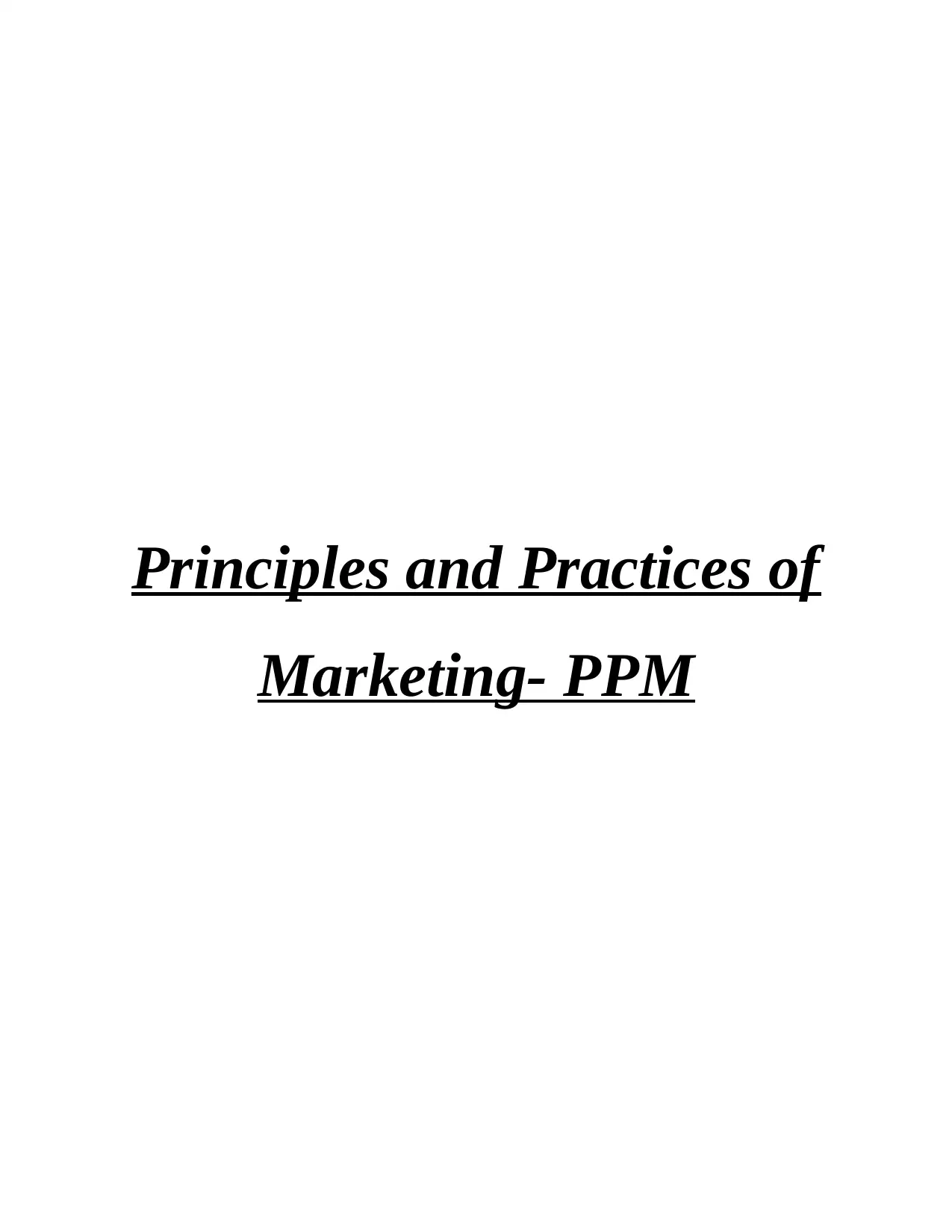
Principles and Practices of
Marketing- PPM
Marketing- PPM
Paraphrase This Document
Need a fresh take? Get an instant paraphrase of this document with our AI Paraphraser

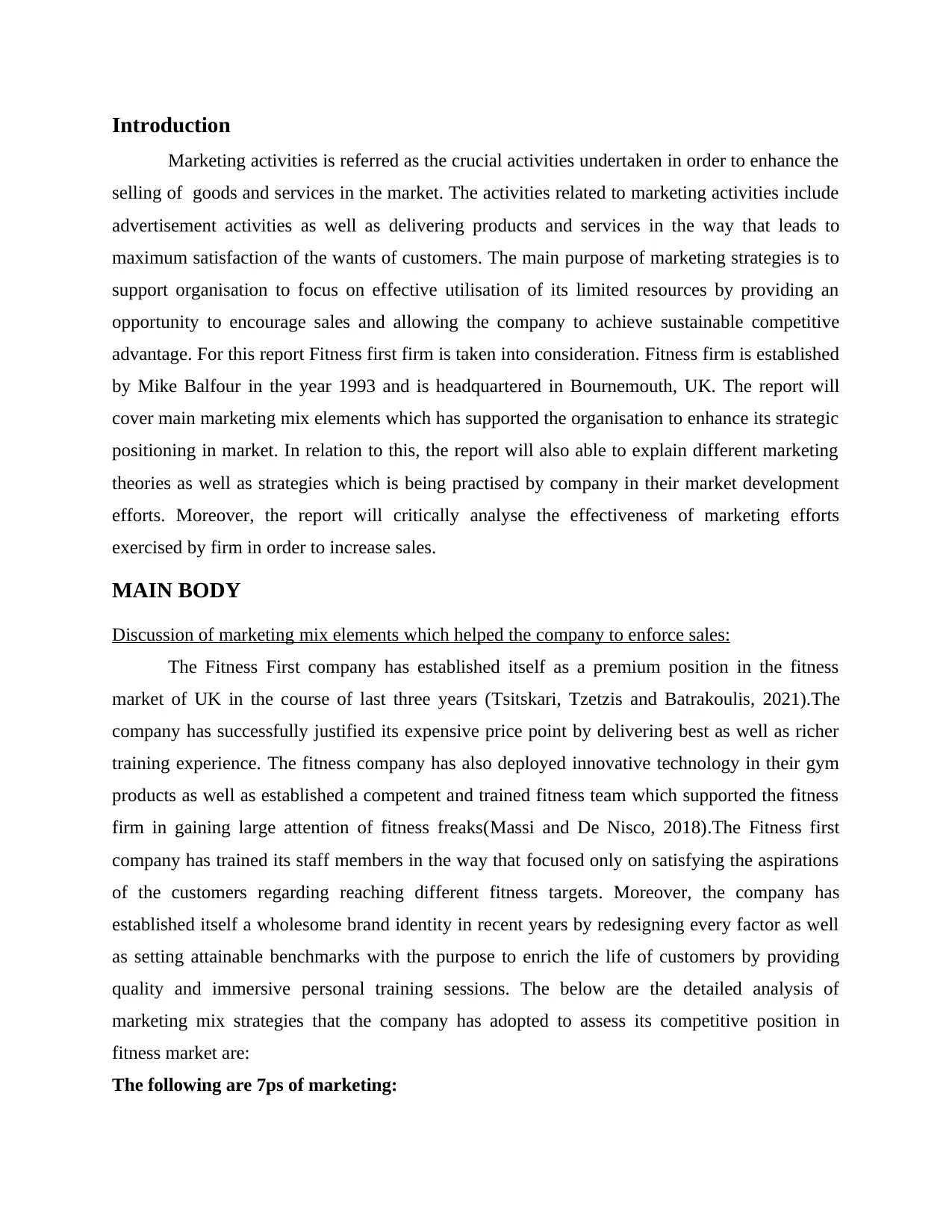
Introduction
Marketing activities is referred as the crucial activities undertaken in order to enhance the
selling of goods and services in the market. The activities related to marketing activities include
advertisement activities as well as delivering products and services in the way that leads to
maximum satisfaction of the wants of customers. The main purpose of marketing strategies is to
support organisation to focus on effective utilisation of its limited resources by providing an
opportunity to encourage sales and allowing the company to achieve sustainable competitive
advantage. For this report Fitness first firm is taken into consideration. Fitness firm is established
by Mike Balfour in the year 1993 and is headquartered in Bournemouth, UK. The report will
cover main marketing mix elements which has supported the organisation to enhance its strategic
positioning in market. In relation to this, the report will also able to explain different marketing
theories as well as strategies which is being practised by company in their market development
efforts. Moreover, the report will critically analyse the effectiveness of marketing efforts
exercised by firm in order to increase sales.
MAIN BODY
Discussion of marketing mix elements which helped the company to enforce sales:
The Fitness First company has established itself as a premium position in the fitness
market of UK in the course of last three years (Tsitskari, Tzetzis and Batrakoulis, 2021).The
company has successfully justified its expensive price point by delivering best as well as richer
training experience. The fitness company has also deployed innovative technology in their gym
products as well as established a competent and trained fitness team which supported the fitness
firm in gaining large attention of fitness freaks(Massi and De Nisco, 2018).The Fitness first
company has trained its staff members in the way that focused only on satisfying the aspirations
of the customers regarding reaching different fitness targets. Moreover, the company has
established itself a wholesome brand identity in recent years by redesigning every factor as well
as setting attainable benchmarks with the purpose to enrich the life of customers by providing
quality and immersive personal training sessions. The below are the detailed analysis of
marketing mix strategies that the company has adopted to assess its competitive position in
fitness market are:
The following are 7ps of marketing:
Marketing activities is referred as the crucial activities undertaken in order to enhance the
selling of goods and services in the market. The activities related to marketing activities include
advertisement activities as well as delivering products and services in the way that leads to
maximum satisfaction of the wants of customers. The main purpose of marketing strategies is to
support organisation to focus on effective utilisation of its limited resources by providing an
opportunity to encourage sales and allowing the company to achieve sustainable competitive
advantage. For this report Fitness first firm is taken into consideration. Fitness firm is established
by Mike Balfour in the year 1993 and is headquartered in Bournemouth, UK. The report will
cover main marketing mix elements which has supported the organisation to enhance its strategic
positioning in market. In relation to this, the report will also able to explain different marketing
theories as well as strategies which is being practised by company in their market development
efforts. Moreover, the report will critically analyse the effectiveness of marketing efforts
exercised by firm in order to increase sales.
MAIN BODY
Discussion of marketing mix elements which helped the company to enforce sales:
The Fitness First company has established itself as a premium position in the fitness
market of UK in the course of last three years (Tsitskari, Tzetzis and Batrakoulis, 2021).The
company has successfully justified its expensive price point by delivering best as well as richer
training experience. The fitness company has also deployed innovative technology in their gym
products as well as established a competent and trained fitness team which supported the fitness
firm in gaining large attention of fitness freaks(Massi and De Nisco, 2018).The Fitness first
company has trained its staff members in the way that focused only on satisfying the aspirations
of the customers regarding reaching different fitness targets. Moreover, the company has
established itself a wholesome brand identity in recent years by redesigning every factor as well
as setting attainable benchmarks with the purpose to enrich the life of customers by providing
quality and immersive personal training sessions. The below are the detailed analysis of
marketing mix strategies that the company has adopted to assess its competitive position in
fitness market are:
The following are 7ps of marketing:
⊘ This is a preview!⊘
Do you want full access?
Subscribe today to unlock all pages.

Trusted by 1+ million students worldwide
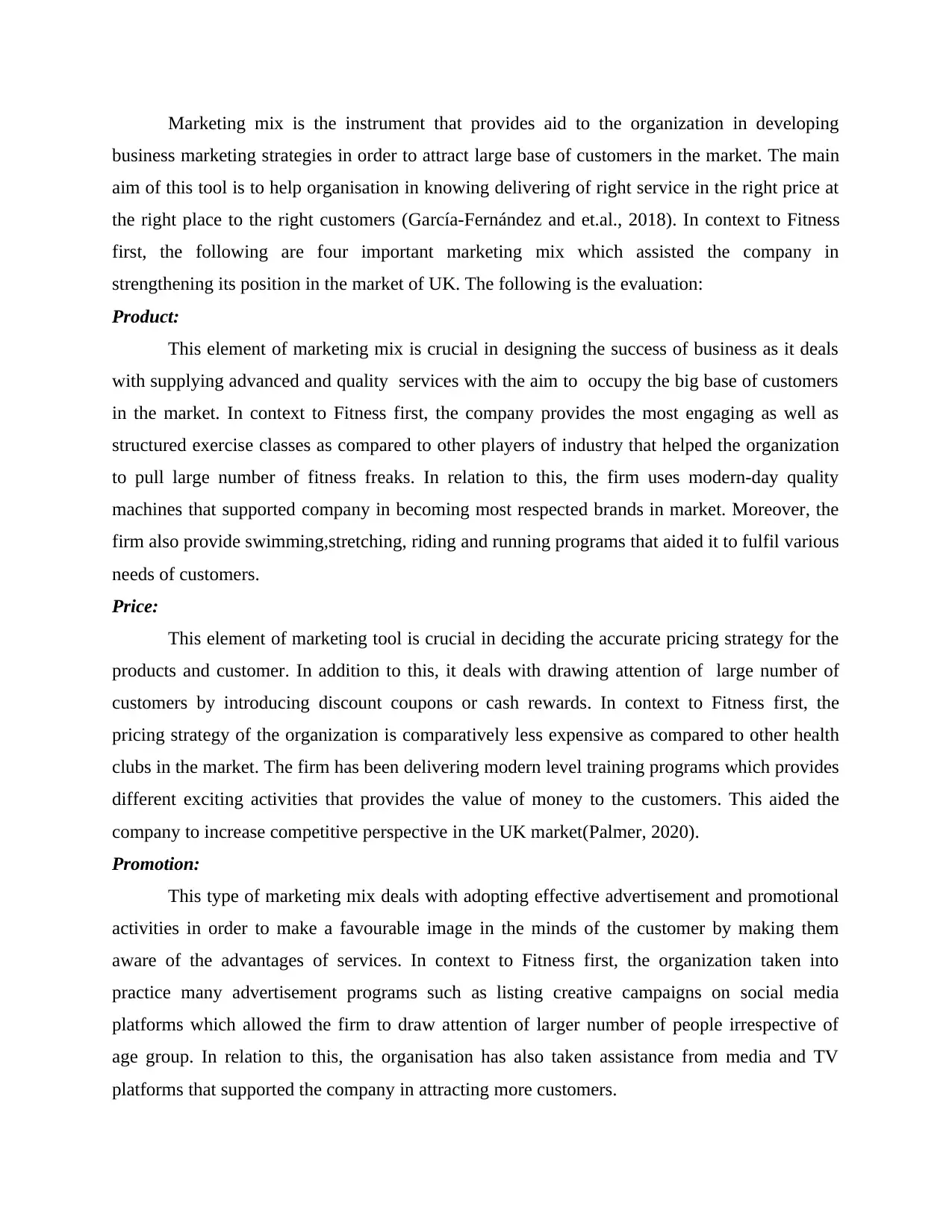
Marketing mix is the instrument that provides aid to the organization in developing
business marketing strategies in order to attract large base of customers in the market. The main
aim of this tool is to help organisation in knowing delivering of right service in the right price at
the right place to the right customers (García-Fernández and et.al., 2018). In context to Fitness
first, the following are four important marketing mix which assisted the company in
strengthening its position in the market of UK. The following is the evaluation:
Product:
This element of marketing mix is crucial in designing the success of business as it deals
with supplying advanced and quality services with the aim to occupy the big base of customers
in the market. In context to Fitness first, the company provides the most engaging as well as
structured exercise classes as compared to other players of industry that helped the organization
to pull large number of fitness freaks. In relation to this, the firm uses modern-day quality
machines that supported company in becoming most respected brands in market. Moreover, the
firm also provide swimming,stretching, riding and running programs that aided it to fulfil various
needs of customers.
Price:
This element of marketing tool is crucial in deciding the accurate pricing strategy for the
products and customer. In addition to this, it deals with drawing attention of large number of
customers by introducing discount coupons or cash rewards. In context to Fitness first, the
pricing strategy of the organization is comparatively less expensive as compared to other health
clubs in the market. The firm has been delivering modern level training programs which provides
different exciting activities that provides the value of money to the customers. This aided the
company to increase competitive perspective in the UK market(Palmer, 2020).
Promotion:
This type of marketing mix deals with adopting effective advertisement and promotional
activities in order to make a favourable image in the minds of the customer by making them
aware of the advantages of services. In context to Fitness first, the organization taken into
practice many advertisement programs such as listing creative campaigns on social media
platforms which allowed the firm to draw attention of larger number of people irrespective of
age group. In relation to this, the organisation has also taken assistance from media and TV
platforms that supported the company in attracting more customers.
business marketing strategies in order to attract large base of customers in the market. The main
aim of this tool is to help organisation in knowing delivering of right service in the right price at
the right place to the right customers (García-Fernández and et.al., 2018). In context to Fitness
first, the following are four important marketing mix which assisted the company in
strengthening its position in the market of UK. The following is the evaluation:
Product:
This element of marketing mix is crucial in designing the success of business as it deals
with supplying advanced and quality services with the aim to occupy the big base of customers
in the market. In context to Fitness first, the company provides the most engaging as well as
structured exercise classes as compared to other players of industry that helped the organization
to pull large number of fitness freaks. In relation to this, the firm uses modern-day quality
machines that supported company in becoming most respected brands in market. Moreover, the
firm also provide swimming,stretching, riding and running programs that aided it to fulfil various
needs of customers.
Price:
This element of marketing tool is crucial in deciding the accurate pricing strategy for the
products and customer. In addition to this, it deals with drawing attention of large number of
customers by introducing discount coupons or cash rewards. In context to Fitness first, the
pricing strategy of the organization is comparatively less expensive as compared to other health
clubs in the market. The firm has been delivering modern level training programs which provides
different exciting activities that provides the value of money to the customers. This aided the
company to increase competitive perspective in the UK market(Palmer, 2020).
Promotion:
This type of marketing mix deals with adopting effective advertisement and promotional
activities in order to make a favourable image in the minds of the customer by making them
aware of the advantages of services. In context to Fitness first, the organization taken into
practice many advertisement programs such as listing creative campaigns on social media
platforms which allowed the firm to draw attention of larger number of people irrespective of
age group. In relation to this, the organisation has also taken assistance from media and TV
platforms that supported the company in attracting more customers.
Paraphrase This Document
Need a fresh take? Get an instant paraphrase of this document with our AI Paraphraser
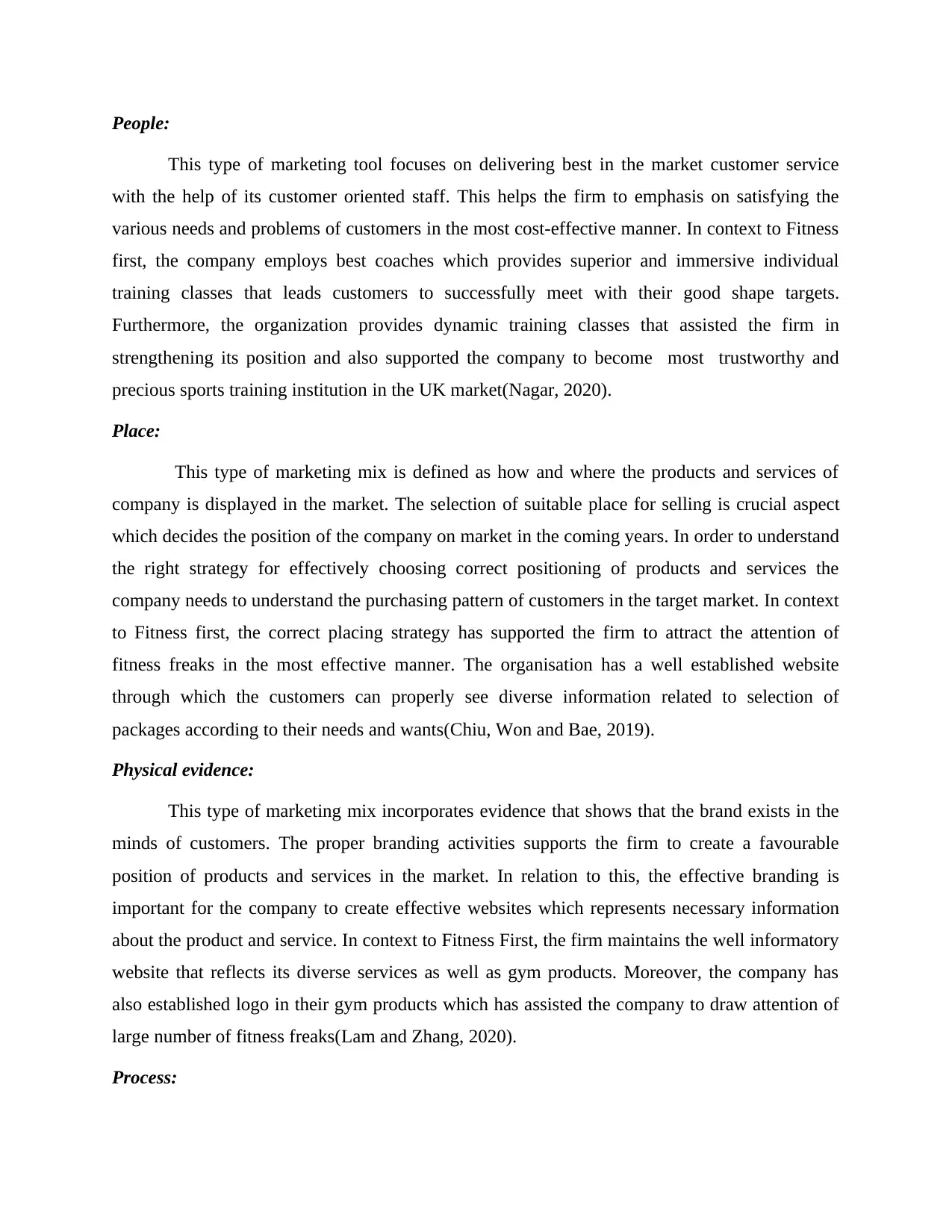
People:
This type of marketing tool focuses on delivering best in the market customer service
with the help of its customer oriented staff. This helps the firm to emphasis on satisfying the
various needs and problems of customers in the most cost-effective manner. In context to Fitness
first, the company employs best coaches which provides superior and immersive individual
training classes that leads customers to successfully meet with their good shape targets.
Furthermore, the organization provides dynamic training classes that assisted the firm in
strengthening its position and also supported the company to become most trustworthy and
precious sports training institution in the UK market(Nagar, 2020).
Place:
This type of marketing mix is defined as how and where the products and services of
company is displayed in the market. The selection of suitable place for selling is crucial aspect
which decides the position of the company on market in the coming years. In order to understand
the right strategy for effectively choosing correct positioning of products and services the
company needs to understand the purchasing pattern of customers in the target market. In context
to Fitness first, the correct placing strategy has supported the firm to attract the attention of
fitness freaks in the most effective manner. The organisation has a well established website
through which the customers can properly see diverse information related to selection of
packages according to their needs and wants(Chiu, Won and Bae, 2019).
Physical evidence:
This type of marketing mix incorporates evidence that shows that the brand exists in the
minds of customers. The proper branding activities supports the firm to create a favourable
position of products and services in the market. In relation to this, the effective branding is
important for the company to create effective websites which represents necessary information
about the product and service. In context to Fitness First, the firm maintains the well informatory
website that reflects its diverse services as well as gym products. Moreover, the company has
also established logo in their gym products which has assisted the company to draw attention of
large number of fitness freaks(Lam and Zhang, 2020).
Process:
This type of marketing tool focuses on delivering best in the market customer service
with the help of its customer oriented staff. This helps the firm to emphasis on satisfying the
various needs and problems of customers in the most cost-effective manner. In context to Fitness
first, the company employs best coaches which provides superior and immersive individual
training classes that leads customers to successfully meet with their good shape targets.
Furthermore, the organization provides dynamic training classes that assisted the firm in
strengthening its position and also supported the company to become most trustworthy and
precious sports training institution in the UK market(Nagar, 2020).
Place:
This type of marketing mix is defined as how and where the products and services of
company is displayed in the market. The selection of suitable place for selling is crucial aspect
which decides the position of the company on market in the coming years. In order to understand
the right strategy for effectively choosing correct positioning of products and services the
company needs to understand the purchasing pattern of customers in the target market. In context
to Fitness first, the correct placing strategy has supported the firm to attract the attention of
fitness freaks in the most effective manner. The organisation has a well established website
through which the customers can properly see diverse information related to selection of
packages according to their needs and wants(Chiu, Won and Bae, 2019).
Physical evidence:
This type of marketing mix incorporates evidence that shows that the brand exists in the
minds of customers. The proper branding activities supports the firm to create a favourable
position of products and services in the market. In relation to this, the effective branding is
important for the company to create effective websites which represents necessary information
about the product and service. In context to Fitness First, the firm maintains the well informatory
website that reflects its diverse services as well as gym products. Moreover, the company has
also established logo in their gym products which has assisted the company to draw attention of
large number of fitness freaks(Lam and Zhang, 2020).
Process:
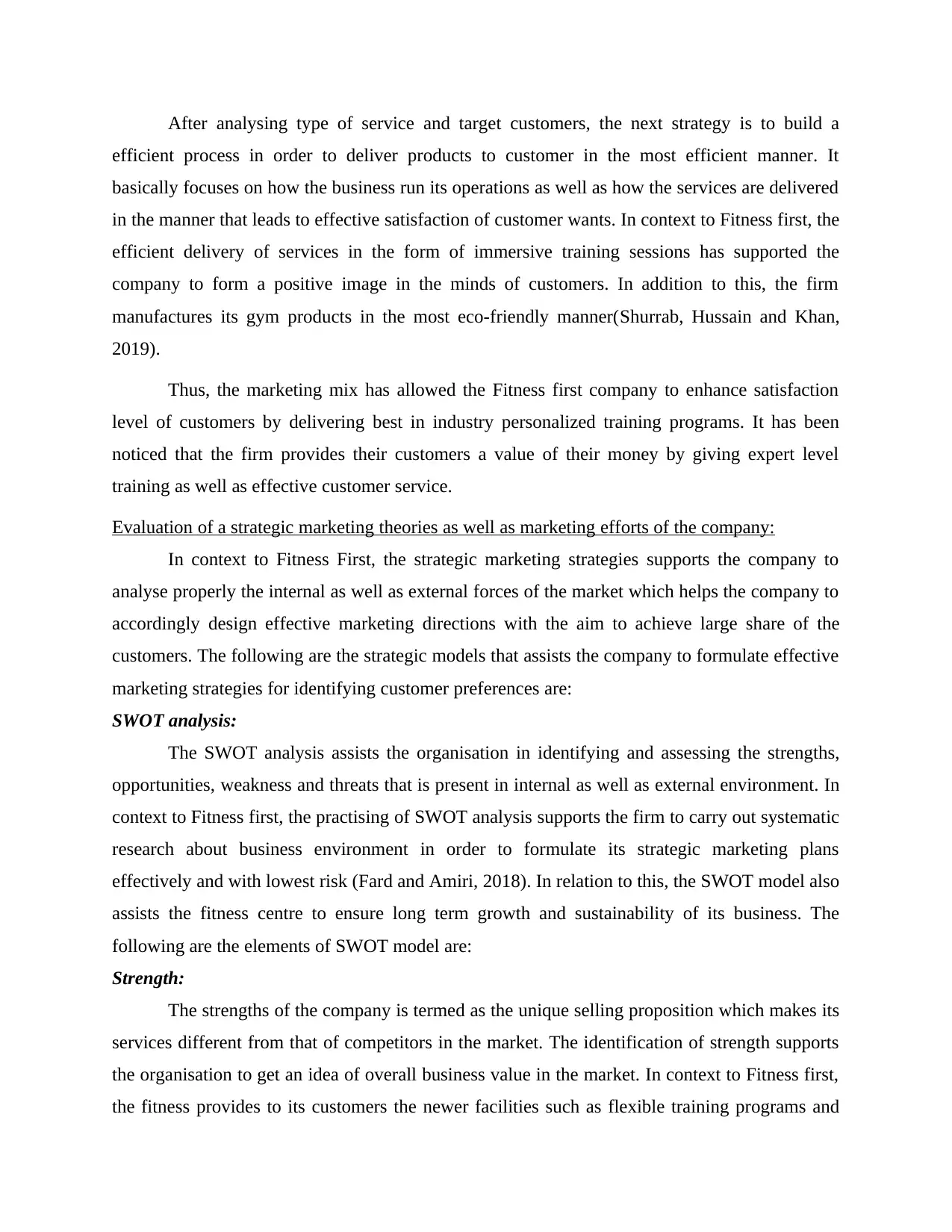
After analysing type of service and target customers, the next strategy is to build a
efficient process in order to deliver products to customer in the most efficient manner. It
basically focuses on how the business run its operations as well as how the services are delivered
in the manner that leads to effective satisfaction of customer wants. In context to Fitness first, the
efficient delivery of services in the form of immersive training sessions has supported the
company to form a positive image in the minds of customers. In addition to this, the firm
manufactures its gym products in the most eco-friendly manner(Shurrab, Hussain and Khan,
2019).
Thus, the marketing mix has allowed the Fitness first company to enhance satisfaction
level of customers by delivering best in industry personalized training programs. It has been
noticed that the firm provides their customers a value of their money by giving expert level
training as well as effective customer service.
Evaluation of a strategic marketing theories as well as marketing efforts of the company:
In context to Fitness First, the strategic marketing strategies supports the company to
analyse properly the internal as well as external forces of the market which helps the company to
accordingly design effective marketing directions with the aim to achieve large share of the
customers. The following are the strategic models that assists the company to formulate effective
marketing strategies for identifying customer preferences are:
SWOT analysis:
The SWOT analysis assists the organisation in identifying and assessing the strengths,
opportunities, weakness and threats that is present in internal as well as external environment. In
context to Fitness first, the practising of SWOT analysis supports the firm to carry out systematic
research about business environment in order to formulate its strategic marketing plans
effectively and with lowest risk (Fard and Amiri, 2018). In relation to this, the SWOT model also
assists the fitness centre to ensure long term growth and sustainability of its business. The
following are the elements of SWOT model are:
Strength:
The strengths of the company is termed as the unique selling proposition which makes its
services different from that of competitors in the market. The identification of strength supports
the organisation to get an idea of overall business value in the market. In context to Fitness first,
the fitness provides to its customers the newer facilities such as flexible training programs and
efficient process in order to deliver products to customer in the most efficient manner. It
basically focuses on how the business run its operations as well as how the services are delivered
in the manner that leads to effective satisfaction of customer wants. In context to Fitness first, the
efficient delivery of services in the form of immersive training sessions has supported the
company to form a positive image in the minds of customers. In addition to this, the firm
manufactures its gym products in the most eco-friendly manner(Shurrab, Hussain and Khan,
2019).
Thus, the marketing mix has allowed the Fitness first company to enhance satisfaction
level of customers by delivering best in industry personalized training programs. It has been
noticed that the firm provides their customers a value of their money by giving expert level
training as well as effective customer service.
Evaluation of a strategic marketing theories as well as marketing efforts of the company:
In context to Fitness First, the strategic marketing strategies supports the company to
analyse properly the internal as well as external forces of the market which helps the company to
accordingly design effective marketing directions with the aim to achieve large share of the
customers. The following are the strategic models that assists the company to formulate effective
marketing strategies for identifying customer preferences are:
SWOT analysis:
The SWOT analysis assists the organisation in identifying and assessing the strengths,
opportunities, weakness and threats that is present in internal as well as external environment. In
context to Fitness first, the practising of SWOT analysis supports the firm to carry out systematic
research about business environment in order to formulate its strategic marketing plans
effectively and with lowest risk (Fard and Amiri, 2018). In relation to this, the SWOT model also
assists the fitness centre to ensure long term growth and sustainability of its business. The
following are the elements of SWOT model are:
Strength:
The strengths of the company is termed as the unique selling proposition which makes its
services different from that of competitors in the market. The identification of strength supports
the organisation to get an idea of overall business value in the market. In context to Fitness first,
the fitness provides to its customers the newer facilities such as flexible training programs and
⊘ This is a preview!⊘
Do you want full access?
Subscribe today to unlock all pages.

Trusted by 1+ million students worldwide
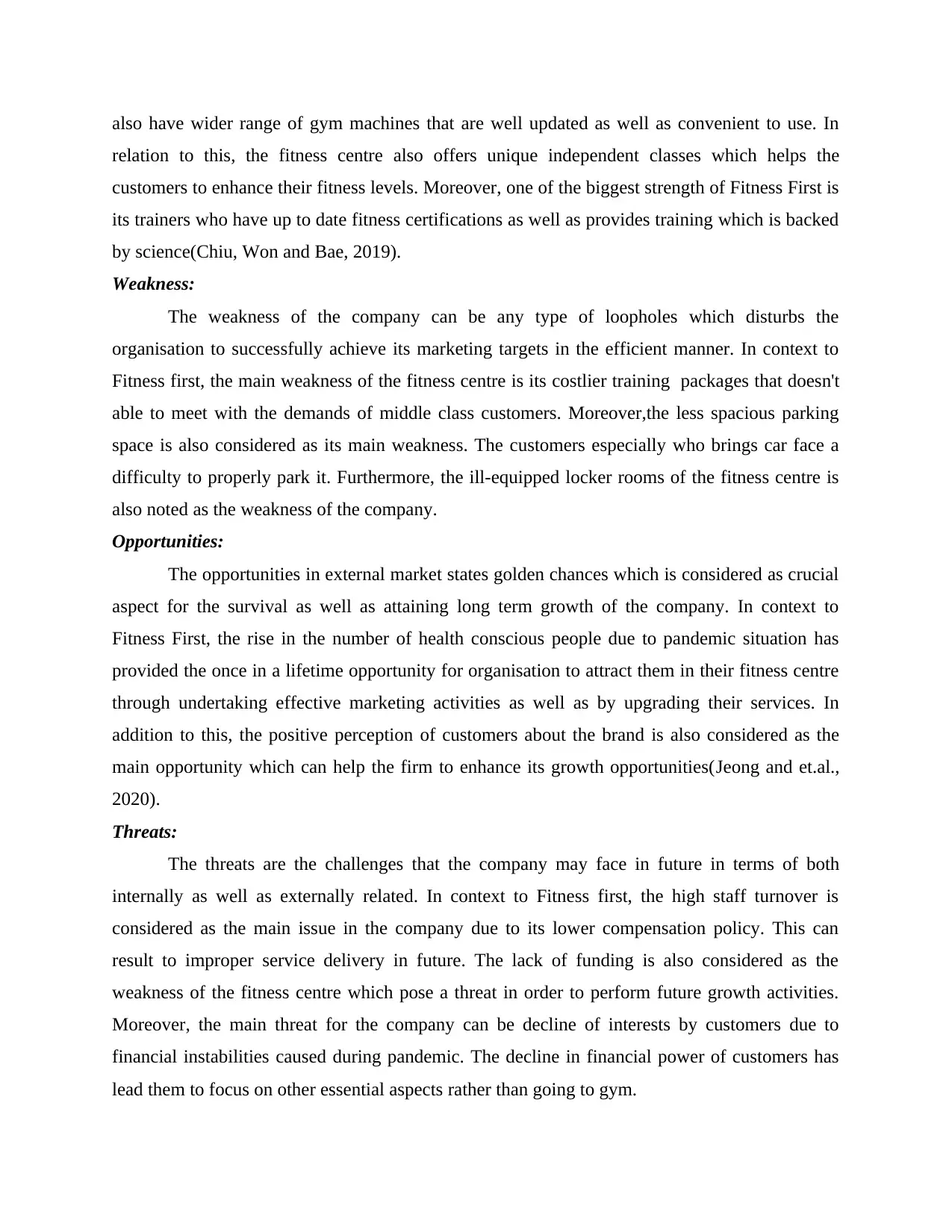
also have wider range of gym machines that are well updated as well as convenient to use. In
relation to this, the fitness centre also offers unique independent classes which helps the
customers to enhance their fitness levels. Moreover, one of the biggest strength of Fitness First is
its trainers who have up to date fitness certifications as well as provides training which is backed
by science(Chiu, Won and Bae, 2019).
Weakness:
The weakness of the company can be any type of loopholes which disturbs the
organisation to successfully achieve its marketing targets in the efficient manner. In context to
Fitness first, the main weakness of the fitness centre is its costlier training packages that doesn't
able to meet with the demands of middle class customers. Moreover,the less spacious parking
space is also considered as its main weakness. The customers especially who brings car face a
difficulty to properly park it. Furthermore, the ill-equipped locker rooms of the fitness centre is
also noted as the weakness of the company.
Opportunities:
The opportunities in external market states golden chances which is considered as crucial
aspect for the survival as well as attaining long term growth of the company. In context to
Fitness First, the rise in the number of health conscious people due to pandemic situation has
provided the once in a lifetime opportunity for organisation to attract them in their fitness centre
through undertaking effective marketing activities as well as by upgrading their services. In
addition to this, the positive perception of customers about the brand is also considered as the
main opportunity which can help the firm to enhance its growth opportunities(Jeong and et.al.,
2020).
Threats:
The threats are the challenges that the company may face in future in terms of both
internally as well as externally related. In context to Fitness first, the high staff turnover is
considered as the main issue in the company due to its lower compensation policy. This can
result to improper service delivery in future. The lack of funding is also considered as the
weakness of the fitness centre which pose a threat in order to perform future growth activities.
Moreover, the main threat for the company can be decline of interests by customers due to
financial instabilities caused during pandemic. The decline in financial power of customers has
lead them to focus on other essential aspects rather than going to gym.
relation to this, the fitness centre also offers unique independent classes which helps the
customers to enhance their fitness levels. Moreover, one of the biggest strength of Fitness First is
its trainers who have up to date fitness certifications as well as provides training which is backed
by science(Chiu, Won and Bae, 2019).
Weakness:
The weakness of the company can be any type of loopholes which disturbs the
organisation to successfully achieve its marketing targets in the efficient manner. In context to
Fitness first, the main weakness of the fitness centre is its costlier training packages that doesn't
able to meet with the demands of middle class customers. Moreover,the less spacious parking
space is also considered as its main weakness. The customers especially who brings car face a
difficulty to properly park it. Furthermore, the ill-equipped locker rooms of the fitness centre is
also noted as the weakness of the company.
Opportunities:
The opportunities in external market states golden chances which is considered as crucial
aspect for the survival as well as attaining long term growth of the company. In context to
Fitness First, the rise in the number of health conscious people due to pandemic situation has
provided the once in a lifetime opportunity for organisation to attract them in their fitness centre
through undertaking effective marketing activities as well as by upgrading their services. In
addition to this, the positive perception of customers about the brand is also considered as the
main opportunity which can help the firm to enhance its growth opportunities(Jeong and et.al.,
2020).
Threats:
The threats are the challenges that the company may face in future in terms of both
internally as well as externally related. In context to Fitness first, the high staff turnover is
considered as the main issue in the company due to its lower compensation policy. This can
result to improper service delivery in future. The lack of funding is also considered as the
weakness of the fitness centre which pose a threat in order to perform future growth activities.
Moreover, the main threat for the company can be decline of interests by customers due to
financial instabilities caused during pandemic. The decline in financial power of customers has
lead them to focus on other essential aspects rather than going to gym.
Paraphrase This Document
Need a fresh take? Get an instant paraphrase of this document with our AI Paraphraser
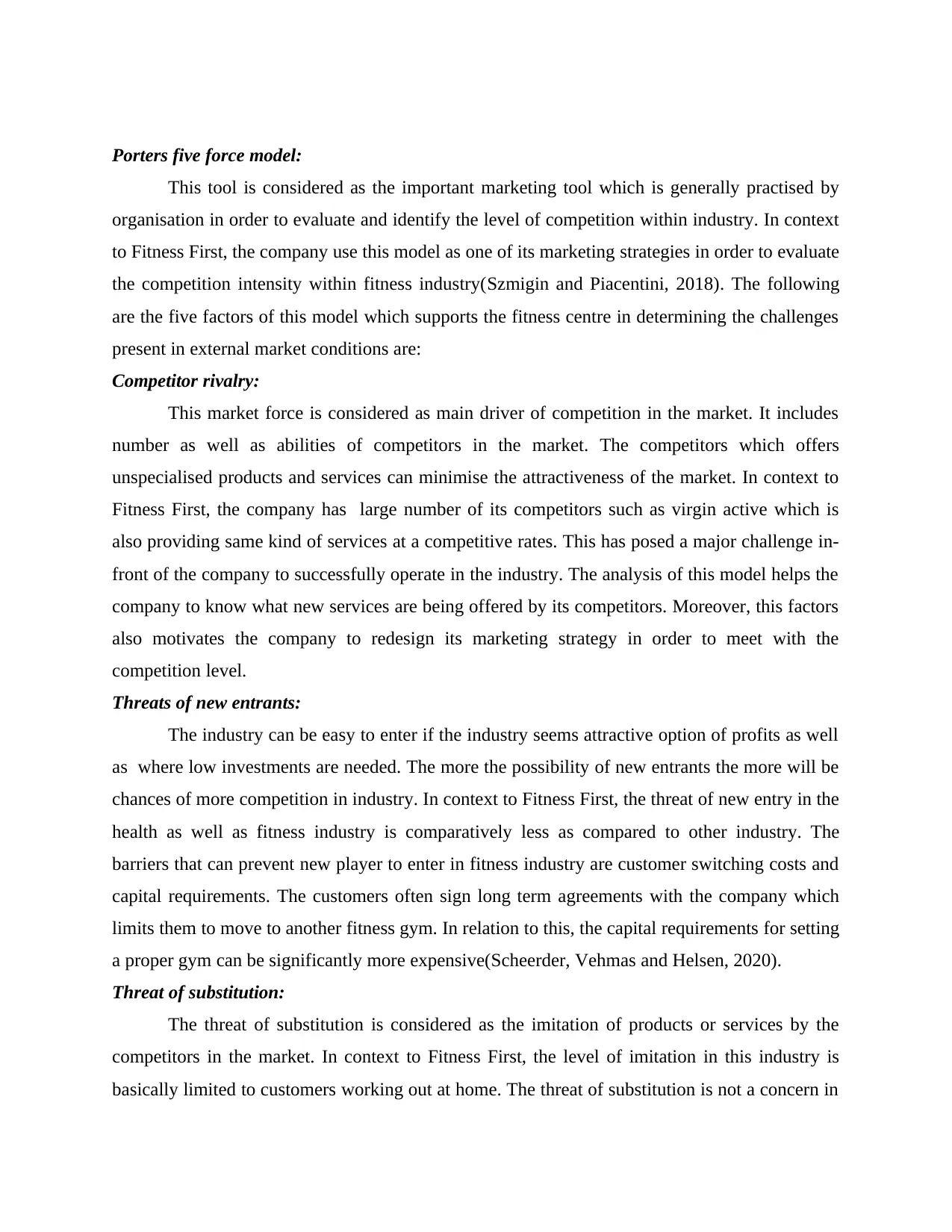
Porters five force model:
This tool is considered as the important marketing tool which is generally practised by
organisation in order to evaluate and identify the level of competition within industry. In context
to Fitness First, the company use this model as one of its marketing strategies in order to evaluate
the competition intensity within fitness industry(Szmigin and Piacentini, 2018). The following
are the five factors of this model which supports the fitness centre in determining the challenges
present in external market conditions are:
Competitor rivalry:
This market force is considered as main driver of competition in the market. It includes
number as well as abilities of competitors in the market. The competitors which offers
unspecialised products and services can minimise the attractiveness of the market. In context to
Fitness First, the company has large number of its competitors such as virgin active which is
also providing same kind of services at a competitive rates. This has posed a major challenge in-
front of the company to successfully operate in the industry. The analysis of this model helps the
company to know what new services are being offered by its competitors. Moreover, this factors
also motivates the company to redesign its marketing strategy in order to meet with the
competition level.
Threats of new entrants:
The industry can be easy to enter if the industry seems attractive option of profits as well
as where low investments are needed. The more the possibility of new entrants the more will be
chances of more competition in industry. In context to Fitness First, the threat of new entry in the
health as well as fitness industry is comparatively less as compared to other industry. The
barriers that can prevent new player to enter in fitness industry are customer switching costs and
capital requirements. The customers often sign long term agreements with the company which
limits them to move to another fitness gym. In relation to this, the capital requirements for setting
a proper gym can be significantly more expensive(Scheerder, Vehmas and Helsen, 2020).
Threat of substitution:
The threat of substitution is considered as the imitation of products or services by the
competitors in the market. In context to Fitness First, the level of imitation in this industry is
basically limited to customers working out at home. The threat of substitution is not a concern in
This tool is considered as the important marketing tool which is generally practised by
organisation in order to evaluate and identify the level of competition within industry. In context
to Fitness First, the company use this model as one of its marketing strategies in order to evaluate
the competition intensity within fitness industry(Szmigin and Piacentini, 2018). The following
are the five factors of this model which supports the fitness centre in determining the challenges
present in external market conditions are:
Competitor rivalry:
This market force is considered as main driver of competition in the market. It includes
number as well as abilities of competitors in the market. The competitors which offers
unspecialised products and services can minimise the attractiveness of the market. In context to
Fitness First, the company has large number of its competitors such as virgin active which is
also providing same kind of services at a competitive rates. This has posed a major challenge in-
front of the company to successfully operate in the industry. The analysis of this model helps the
company to know what new services are being offered by its competitors. Moreover, this factors
also motivates the company to redesign its marketing strategy in order to meet with the
competition level.
Threats of new entrants:
The industry can be easy to enter if the industry seems attractive option of profits as well
as where low investments are needed. The more the possibility of new entrants the more will be
chances of more competition in industry. In context to Fitness First, the threat of new entry in the
health as well as fitness industry is comparatively less as compared to other industry. The
barriers that can prevent new player to enter in fitness industry are customer switching costs and
capital requirements. The customers often sign long term agreements with the company which
limits them to move to another fitness gym. In relation to this, the capital requirements for setting
a proper gym can be significantly more expensive(Scheerder, Vehmas and Helsen, 2020).
Threat of substitution:
The threat of substitution is considered as the imitation of products or services by the
competitors in the market. In context to Fitness First, the level of imitation in this industry is
basically limited to customers working out at home. The threat of substitution is not a concern in
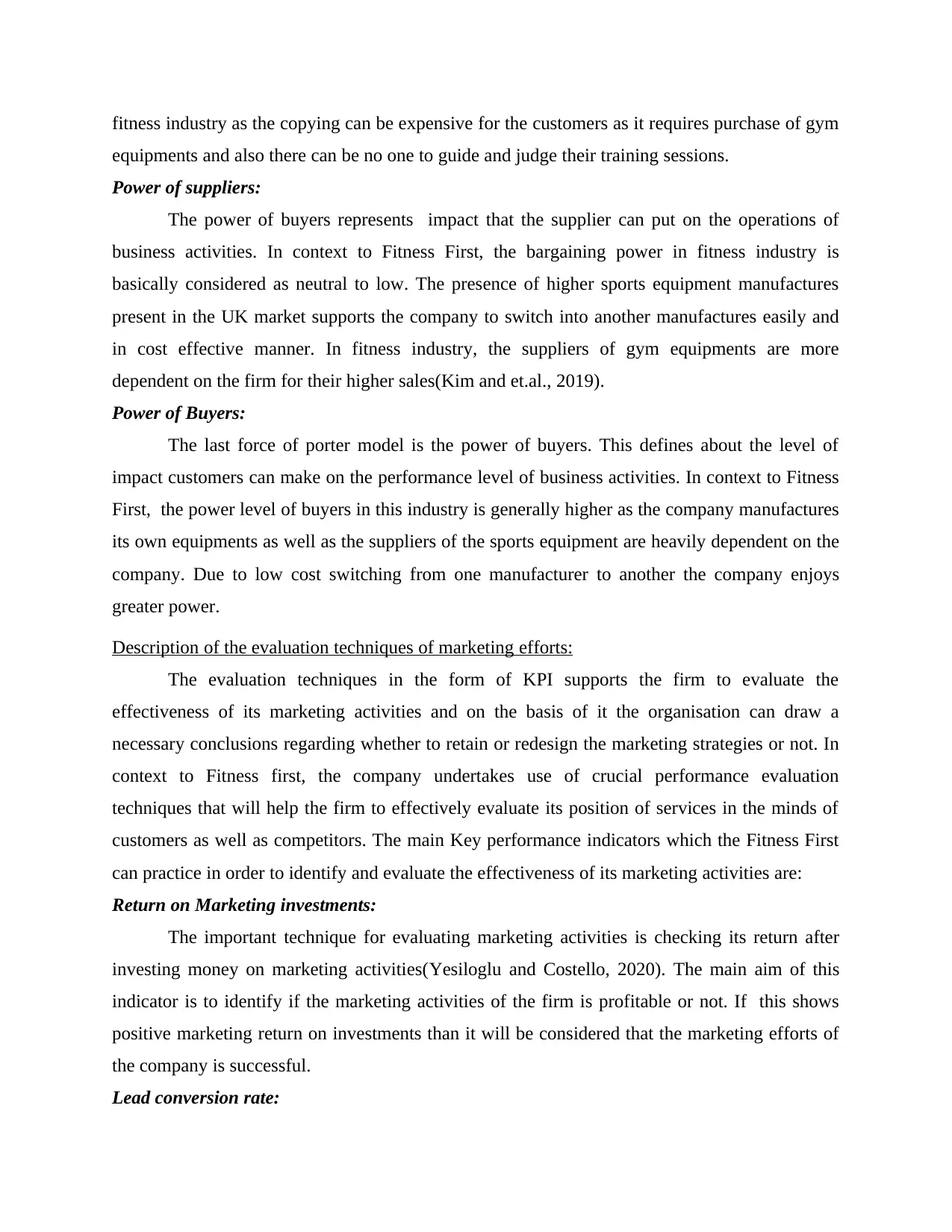
fitness industry as the copying can be expensive for the customers as it requires purchase of gym
equipments and also there can be no one to guide and judge their training sessions.
Power of suppliers:
The power of buyers represents impact that the supplier can put on the operations of
business activities. In context to Fitness First, the bargaining power in fitness industry is
basically considered as neutral to low. The presence of higher sports equipment manufactures
present in the UK market supports the company to switch into another manufactures easily and
in cost effective manner. In fitness industry, the suppliers of gym equipments are more
dependent on the firm for their higher sales(Kim and et.al., 2019).
Power of Buyers:
The last force of porter model is the power of buyers. This defines about the level of
impact customers can make on the performance level of business activities. In context to Fitness
First, the power level of buyers in this industry is generally higher as the company manufactures
its own equipments as well as the suppliers of the sports equipment are heavily dependent on the
company. Due to low cost switching from one manufacturer to another the company enjoys
greater power.
Description of the evaluation techniques of marketing efforts:
The evaluation techniques in the form of KPI supports the firm to evaluate the
effectiveness of its marketing activities and on the basis of it the organisation can draw a
necessary conclusions regarding whether to retain or redesign the marketing strategies or not. In
context to Fitness first, the company undertakes use of crucial performance evaluation
techniques that will help the firm to effectively evaluate its position of services in the minds of
customers as well as competitors. The main Key performance indicators which the Fitness First
can practice in order to identify and evaluate the effectiveness of its marketing activities are:
Return on Marketing investments:
The important technique for evaluating marketing activities is checking its return after
investing money on marketing activities(Yesiloglu and Costello, 2020). The main aim of this
indicator is to identify if the marketing activities of the firm is profitable or not. If this shows
positive marketing return on investments than it will be considered that the marketing efforts of
the company is successful.
Lead conversion rate:
equipments and also there can be no one to guide and judge their training sessions.
Power of suppliers:
The power of buyers represents impact that the supplier can put on the operations of
business activities. In context to Fitness First, the bargaining power in fitness industry is
basically considered as neutral to low. The presence of higher sports equipment manufactures
present in the UK market supports the company to switch into another manufactures easily and
in cost effective manner. In fitness industry, the suppliers of gym equipments are more
dependent on the firm for their higher sales(Kim and et.al., 2019).
Power of Buyers:
The last force of porter model is the power of buyers. This defines about the level of
impact customers can make on the performance level of business activities. In context to Fitness
First, the power level of buyers in this industry is generally higher as the company manufactures
its own equipments as well as the suppliers of the sports equipment are heavily dependent on the
company. Due to low cost switching from one manufacturer to another the company enjoys
greater power.
Description of the evaluation techniques of marketing efforts:
The evaluation techniques in the form of KPI supports the firm to evaluate the
effectiveness of its marketing activities and on the basis of it the organisation can draw a
necessary conclusions regarding whether to retain or redesign the marketing strategies or not. In
context to Fitness first, the company undertakes use of crucial performance evaluation
techniques that will help the firm to effectively evaluate its position of services in the minds of
customers as well as competitors. The main Key performance indicators which the Fitness First
can practice in order to identify and evaluate the effectiveness of its marketing activities are:
Return on Marketing investments:
The important technique for evaluating marketing activities is checking its return after
investing money on marketing activities(Yesiloglu and Costello, 2020). The main aim of this
indicator is to identify if the marketing activities of the firm is profitable or not. If this shows
positive marketing return on investments than it will be considered that the marketing efforts of
the company is successful.
Lead conversion rate:
⊘ This is a preview!⊘
Do you want full access?
Subscribe today to unlock all pages.

Trusted by 1+ million students worldwide
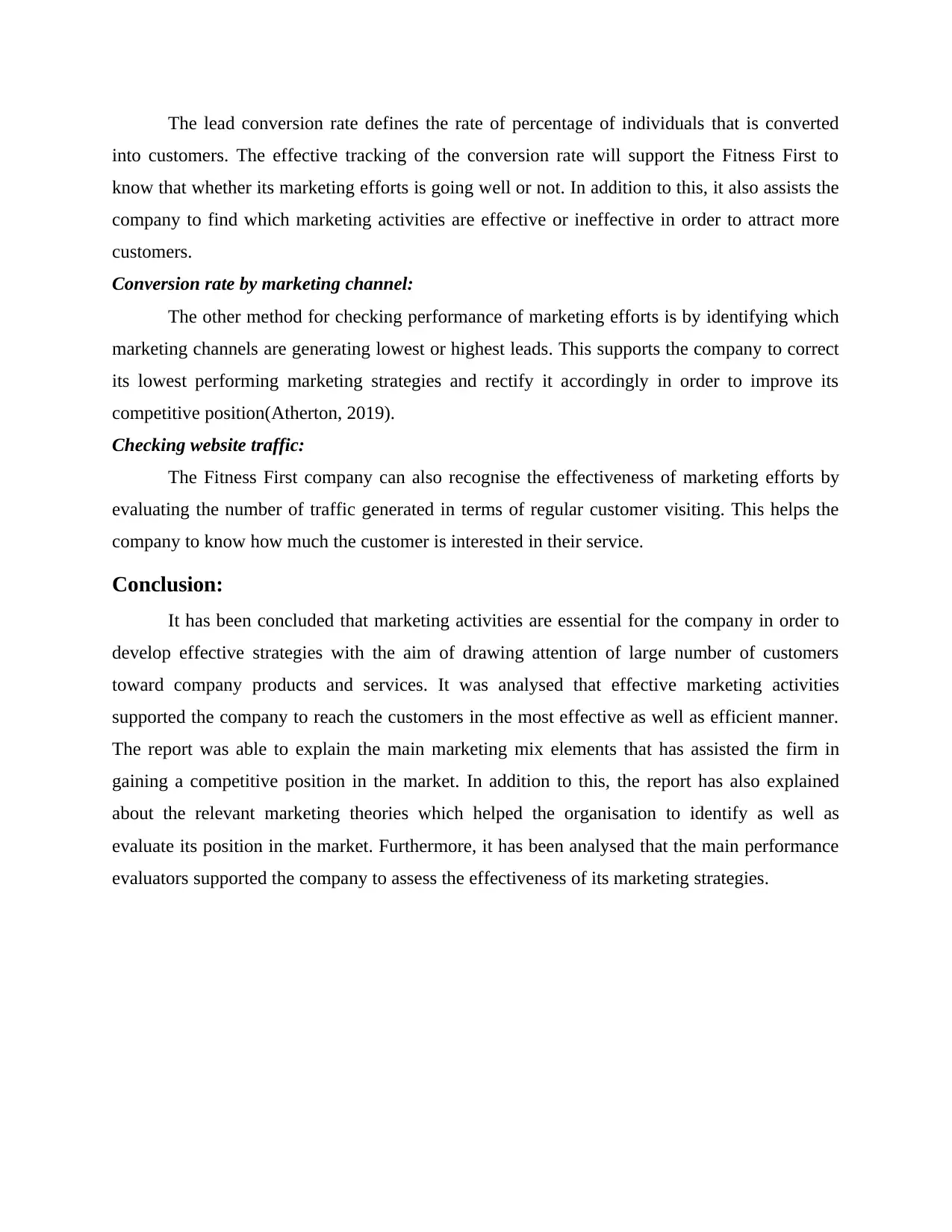
The lead conversion rate defines the rate of percentage of individuals that is converted
into customers. The effective tracking of the conversion rate will support the Fitness First to
know that whether its marketing efforts is going well or not. In addition to this, it also assists the
company to find which marketing activities are effective or ineffective in order to attract more
customers.
Conversion rate by marketing channel:
The other method for checking performance of marketing efforts is by identifying which
marketing channels are generating lowest or highest leads. This supports the company to correct
its lowest performing marketing strategies and rectify it accordingly in order to improve its
competitive position(Atherton, 2019).
Checking website traffic:
The Fitness First company can also recognise the effectiveness of marketing efforts by
evaluating the number of traffic generated in terms of regular customer visiting. This helps the
company to know how much the customer is interested in their service.
Conclusion:
It has been concluded that marketing activities are essential for the company in order to
develop effective strategies with the aim of drawing attention of large number of customers
toward company products and services. It was analysed that effective marketing activities
supported the company to reach the customers in the most effective as well as efficient manner.
The report was able to explain the main marketing mix elements that has assisted the firm in
gaining a competitive position in the market. In addition to this, the report has also explained
about the relevant marketing theories which helped the organisation to identify as well as
evaluate its position in the market. Furthermore, it has been analysed that the main performance
evaluators supported the company to assess the effectiveness of its marketing strategies.
into customers. The effective tracking of the conversion rate will support the Fitness First to
know that whether its marketing efforts is going well or not. In addition to this, it also assists the
company to find which marketing activities are effective or ineffective in order to attract more
customers.
Conversion rate by marketing channel:
The other method for checking performance of marketing efforts is by identifying which
marketing channels are generating lowest or highest leads. This supports the company to correct
its lowest performing marketing strategies and rectify it accordingly in order to improve its
competitive position(Atherton, 2019).
Checking website traffic:
The Fitness First company can also recognise the effectiveness of marketing efforts by
evaluating the number of traffic generated in terms of regular customer visiting. This helps the
company to know how much the customer is interested in their service.
Conclusion:
It has been concluded that marketing activities are essential for the company in order to
develop effective strategies with the aim of drawing attention of large number of customers
toward company products and services. It was analysed that effective marketing activities
supported the company to reach the customers in the most effective as well as efficient manner.
The report was able to explain the main marketing mix elements that has assisted the firm in
gaining a competitive position in the market. In addition to this, the report has also explained
about the relevant marketing theories which helped the organisation to identify as well as
evaluate its position in the market. Furthermore, it has been analysed that the main performance
evaluators supported the company to assess the effectiveness of its marketing strategies.
Paraphrase This Document
Need a fresh take? Get an instant paraphrase of this document with our AI Paraphraser
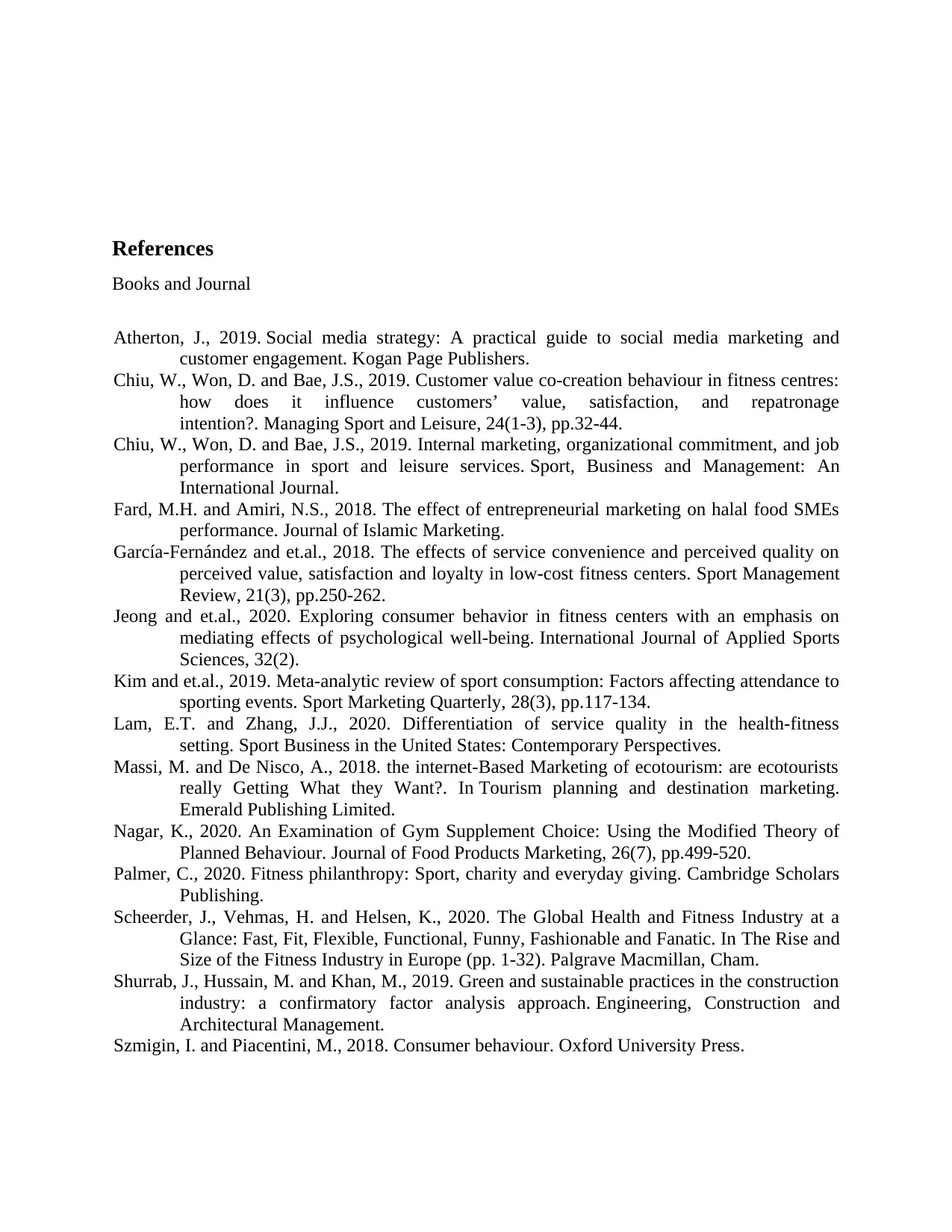
References
Books and Journal
Atherton, J., 2019. Social media strategy: A practical guide to social media marketing and
customer engagement. Kogan Page Publishers.
Chiu, W., Won, D. and Bae, J.S., 2019. Customer value co-creation behaviour in fitness centres:
how does it influence customers’ value, satisfaction, and repatronage
intention?. Managing Sport and Leisure, 24(1-3), pp.32-44.
Chiu, W., Won, D. and Bae, J.S., 2019. Internal marketing, organizational commitment, and job
performance in sport and leisure services. Sport, Business and Management: An
International Journal.
Fard, M.H. and Amiri, N.S., 2018. The effect of entrepreneurial marketing on halal food SMEs
performance. Journal of Islamic Marketing.
García-Fernández and et.al., 2018. The effects of service convenience and perceived quality on
perceived value, satisfaction and loyalty in low-cost fitness centers. Sport Management
Review, 21(3), pp.250-262.
Jeong and et.al., 2020. Exploring consumer behavior in fitness centers with an emphasis on
mediating effects of psychological well-being. International Journal of Applied Sports
Sciences, 32(2).
Kim and et.al., 2019. Meta-analytic review of sport consumption: Factors affecting attendance to
sporting events. Sport Marketing Quarterly, 28(3), pp.117-134.
Lam, E.T. and Zhang, J.J., 2020. Differentiation of service quality in the health-fitness
setting. Sport Business in the United States: Contemporary Perspectives.
Massi, M. and De Nisco, A., 2018. the internet-Based Marketing of ecotourism: are ecotourists
really Getting What they Want?. In Tourism planning and destination marketing.
Emerald Publishing Limited.
Nagar, K., 2020. An Examination of Gym Supplement Choice: Using the Modified Theory of
Planned Behaviour. Journal of Food Products Marketing, 26(7), pp.499-520.
Palmer, C., 2020. Fitness philanthropy: Sport, charity and everyday giving. Cambridge Scholars
Publishing.
Scheerder, J., Vehmas, H. and Helsen, K., 2020. The Global Health and Fitness Industry at a
Glance: Fast, Fit, Flexible, Functional, Funny, Fashionable and Fanatic. In The Rise and
Size of the Fitness Industry in Europe (pp. 1-32). Palgrave Macmillan, Cham.
Shurrab, J., Hussain, M. and Khan, M., 2019. Green and sustainable practices in the construction
industry: a confirmatory factor analysis approach. Engineering, Construction and
Architectural Management.
Szmigin, I. and Piacentini, M., 2018. Consumer behaviour. Oxford University Press.
Books and Journal
Atherton, J., 2019. Social media strategy: A practical guide to social media marketing and
customer engagement. Kogan Page Publishers.
Chiu, W., Won, D. and Bae, J.S., 2019. Customer value co-creation behaviour in fitness centres:
how does it influence customers’ value, satisfaction, and repatronage
intention?. Managing Sport and Leisure, 24(1-3), pp.32-44.
Chiu, W., Won, D. and Bae, J.S., 2019. Internal marketing, organizational commitment, and job
performance in sport and leisure services. Sport, Business and Management: An
International Journal.
Fard, M.H. and Amiri, N.S., 2018. The effect of entrepreneurial marketing on halal food SMEs
performance. Journal of Islamic Marketing.
García-Fernández and et.al., 2018. The effects of service convenience and perceived quality on
perceived value, satisfaction and loyalty in low-cost fitness centers. Sport Management
Review, 21(3), pp.250-262.
Jeong and et.al., 2020. Exploring consumer behavior in fitness centers with an emphasis on
mediating effects of psychological well-being. International Journal of Applied Sports
Sciences, 32(2).
Kim and et.al., 2019. Meta-analytic review of sport consumption: Factors affecting attendance to
sporting events. Sport Marketing Quarterly, 28(3), pp.117-134.
Lam, E.T. and Zhang, J.J., 2020. Differentiation of service quality in the health-fitness
setting. Sport Business in the United States: Contemporary Perspectives.
Massi, M. and De Nisco, A., 2018. the internet-Based Marketing of ecotourism: are ecotourists
really Getting What they Want?. In Tourism planning and destination marketing.
Emerald Publishing Limited.
Nagar, K., 2020. An Examination of Gym Supplement Choice: Using the Modified Theory of
Planned Behaviour. Journal of Food Products Marketing, 26(7), pp.499-520.
Palmer, C., 2020. Fitness philanthropy: Sport, charity and everyday giving. Cambridge Scholars
Publishing.
Scheerder, J., Vehmas, H. and Helsen, K., 2020. The Global Health and Fitness Industry at a
Glance: Fast, Fit, Flexible, Functional, Funny, Fashionable and Fanatic. In The Rise and
Size of the Fitness Industry in Europe (pp. 1-32). Palgrave Macmillan, Cham.
Shurrab, J., Hussain, M. and Khan, M., 2019. Green and sustainable practices in the construction
industry: a confirmatory factor analysis approach. Engineering, Construction and
Architectural Management.
Szmigin, I. and Piacentini, M., 2018. Consumer behaviour. Oxford University Press.

Tsitskari, E., Tzetzis, G. and Batrakoulis, A., 2021. The Fitness Sector in Greece: Business
Models and Marketing Perspectives. In The Global Private Health & Fitness Business:
A Marketing Perspective. Emerald Publishing Limited.
Yesiloglu, S. and Costello, J. eds., 2020. Influencer Marketing: Building Brand Communities
and Engagement. Routledge.
Models and Marketing Perspectives. In The Global Private Health & Fitness Business:
A Marketing Perspective. Emerald Publishing Limited.
Yesiloglu, S. and Costello, J. eds., 2020. Influencer Marketing: Building Brand Communities
and Engagement. Routledge.
⊘ This is a preview!⊘
Do you want full access?
Subscribe today to unlock all pages.

Trusted by 1+ million students worldwide
1 out of 12
Related Documents
Your All-in-One AI-Powered Toolkit for Academic Success.
+13062052269
info@desklib.com
Available 24*7 on WhatsApp / Email
![[object Object]](/_next/static/media/star-bottom.7253800d.svg)
Unlock your academic potential
Copyright © 2020–2025 A2Z Services. All Rights Reserved. Developed and managed by ZUCOL.



